Posts: 410
Threads: 17
Joined: Dec 2008
jwb Wrote:[ATTACHMENT NOT FOUND]
Whoa! What is that UP boxcar in teh background and where did you find it? I've been looking everywhere for one of those!
Tom Carter
Railroad Training Services
Railroad Trainers & Consultants
Stockton, CA
<!-- m --><a class="postlink" href="http://www.railroadtrainingservices.com">http://www.railroadtrainingservices.com</a><!-- m -->
<!-- e --><a href="mailto:tomwcarter@railroadtrainingservices.com">tomwcarter@railroadtrainingservices.com</a><!-- e -->
![[Image: gaugetraingifsigUP.gif]](http://i79.photobucket.com/albums/j137/wprm/gaugetraingifsigUP.gif)
It's probably what you think it is, an Ambroid UP 60-foot express/passenger service box. I got it about 1970 and built it before I was smart enough to add weight.
Here's the current status of the Campbell talc plant. I had enough of my remaining Paper Creek corrugated siding and roofing that I was able to substitute that for the Campbell corrugated material in the kit. I haven't decided what I'm going to do with the roof on the annex (which is what the kit instructions call the "bag house" ) on the right.
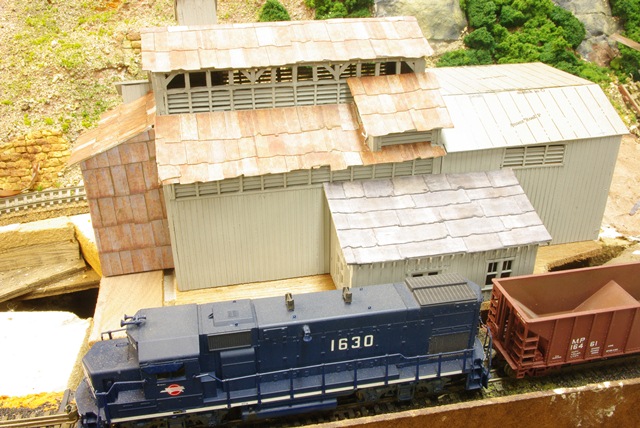
There are just some details and finishing touches to go, so I need to get serious about preparing the site.
Posts: 410
Threads: 17
Joined: Dec 2008
jwb Wrote:It's probably what you think it is, an Ambroid UP 60-foot express/passenger service box. I got it about 1970 and built it before I was smart enough to add weight.
You wouldn't want to trade it for something else would you? I've got all kinds of engines, cars, etc. Let me know if you're interested.
Tom Carter
Railroad Training Services
Railroad Trainers & Consultants
Stockton, CA
<!-- m --><a class="postlink" href="http://www.railroadtrainingservices.com">http://www.railroadtrainingservices.com</a><!-- m -->
<!-- e --><a href="mailto:tomwcarter@railroadtrainingservices.com">tomwcarter@railroadtrainingservices.com</a><!-- e -->
![[Image: gaugetraingifsigUP.gif]](http://i79.photobucket.com/albums/j137/wprm/gaugetraingifsigUP.gif)
Too much sentimental value, I'm afraid. And someone came out with a brass model once -- there's simply no comparison, get the brass one if you can find it!
I've gotten to the point of cutting away a scenery area and installing a scenic base for the American Model Builders Virginian depot that I planned to put here:
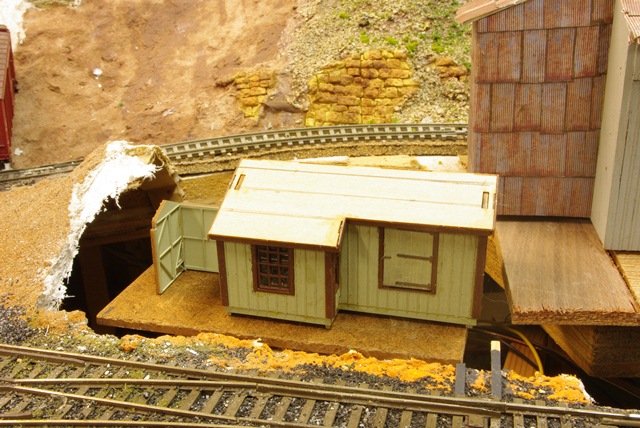
It's really helpful to take photos during projects like this, and to see some of the good photos other guys post here, because now I realize I should grade a parkng area behind the depot. (And in fact just plain finish the depot!)
Here's a slightly farther-out view of the area I'm working on here -- it's a continuation to the left of the challenge area with the coal mine that I'd been working on in that series earlier this year. I'm now almost finished with the AMB Virginian depot, and I've added a scenic base for the parking area behind it. There will be a private road crossing roughly under the loco's fuel tank. Left to right in the photo is a Yorke G Street Warehouse that still needs work (after a dozen years sitting like that), the AMB station, and the Campbell talc/fertilizer plant. Above and to the left is a scratchbuilt barn with Blair Line Rock City decal. My objective now will be to add plaster cloth scenery form to the depot and fertilizer/talc plant area, add the highway crossing, finish the bleepin' G Street Warehouse, and complete the scenery area above it around and behind the barn.
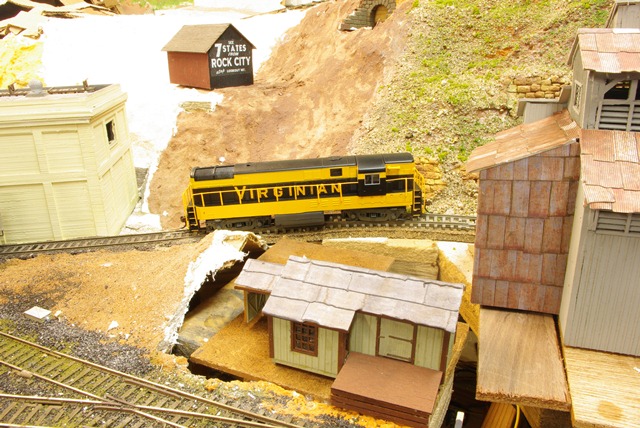
I need to do some work on my Bachmann VGN FMs, too.
Posts: 1,992
Threads: 81
Joined: Dec 2008
jwb Wrote:Here's an area I haven't covered yet. When I designed this layout in 1993, I realized that i'd lived in so many places, traveled so much, and had so many interests that it would be folly to say "I'm going to model a Santa Fe branch line in Texas on September 23, 1948, just before they withdrew the xxx class". My job was going to be to evaluate the range of interests I had and find a way to accommodate predictable changes in focus. This section of the layout was designed to let me do things with one set of interests, on one hand PRR-Amtrak Northeast Corridor, and on the other European main line electrification.[ATTACHMENT NOT FOUND]The trackwork here isn't even finished, and most of it isn't wired. I have the materials eventually to install Sommerfeldt German style catenary, but I expect to run Amtrak and PRR electrics as well. In fact, the track plan is designed to let me detour main line US type freights onto this loop, change engines, and run with electrics until I decide to go back to diesel operation. Chris-GEC's posts have been prodding me to get interested in this part of the layout again.
Hmm, I missed this the first time around! That would be cool to see some E33s and GG1s making that run under all that wire. You might be able to go for a "South Amboy" like run as well, swapping passenger trains!
Quote:I bring this up because I was going through some past swap meet treasures and came up with this:[It's a dummy Walthers version of the American GK E60. I've run into several of these at swaps over the years. I'm now thinking this could become a scenery item. I've never fully decided what I'm going to put in the upper left area of the scene above, but now I'm thinking I may add a scenery-only motor storage track there and put a couple of dummy or non-runnable locos on display.
Well, not that I would do this, BUT, technically 955 smacked into a fallen catenary pole during a light engine move in 1984. It was rebuilt and put back into service (it actually eventually became 610, the last locomotive to pull the Broadway Limited), but not before they cut the front end off! If you felt brave, you could model the locomotive in its "Damaged" condition, on its way to a repair facility.
This isn't the best picture, but I might be able to scan others from my books.
![[Image: 2003110513255716272.jpg]](http://imagestorage.nerail.org/photos/2003/11/05/2003110513255716272.jpg)
Modeling New Jersey Under the Wire 1978-1979.
![[Image: logosmall.png]](http://i543.photobucket.com/albums/gg445/CAB_IV/Model%20Trains%202013/logosmall.png)
Posts: 1,992
Threads: 81
Joined: Dec 2008
faraway Wrote:That is the way all German stations look. It is a lot of work but a well done catenary over a bunch of switches is an outstanding detail. Is Sommerfeldt catenary useful for an US based layout?
As was noted, only in a few places. In general, simple structures made from H-columns were preferred for cantenary constructon on most railroads prior to the 1980s, though it was hardly the rule.
Most modern Light-rail lines I've seen would use compatible catenary with the sommerfeldt types.
The New Haven to Boston route also has these European style poles, as well as the electrification from South Amboy to Long Branch on New Jersey Transit, completed in 1983.
IndyCity Wrote:Unfortunately only a few parts, Reinhard.
Look here - this is a good adress for american catenary systems: http://www.modelmemories.com/
Wow, I haven't been to Model Memmories in a while! It is sad to hear their prices have only increased, however.
On the other hand, its good to see that they have expanded their line to carry other railroads than the PRR and New Haven. I kind wish they would make some "over-running" third rail, such as that on the PATCO and other rail lines (model memmories has "under running" third rail kits. The difference is the third rail shoe is either "on" or "under" the third rail, respectively).
Some of the fancier Reading and DL&W supports might have been nice as well, but then most of these can be easily constructed from brass shapes (WAY easier than the PRR stuff).
I went to scratchbuilding to avoid the costs of model memmories, since I knew I would have to custom cut poles, and I just didn't want to put all that money in. I'm saving a little money by doing it my way, as opposed to buying the kits they sold.
Modeling New Jersey Under the Wire 1978-1979.
![[Image: logosmall.png]](http://i543.photobucket.com/albums/gg445/CAB_IV/Model%20Trains%202013/logosmall.png)
The Virginian was one of the first prototype railroads that inspired my interest -- I was maybe 12 years old when it merged into the N&W, and I was just starting to realize there were individual railroads that went to particular places, with individual characters. I've picked up most of the books and videos covering the VGN over the years, and while I like it, I'm realizing it's not the best railroad to model for a number of reasons, the really great MR project layout aside. Nevertheless, it's one of my "minors". I realized earlier this year that Bachmann had come out with new runs of the VGN FM H16-44, with much improved paint from the 1990s version, better wheels, and smoother opertion generally. I got one of the new ones very cheaply off Amazon, plus a new body shell to update a 1990s I already had:
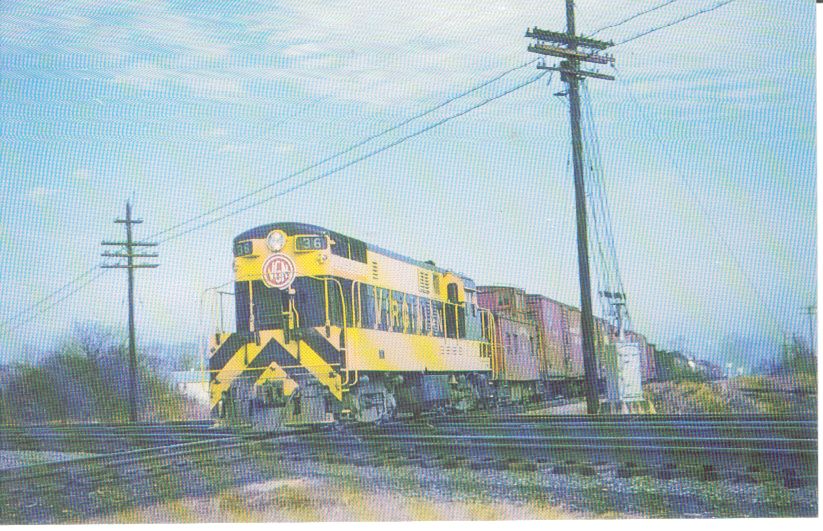
This is in the spirit of some of Reinhard's Bachmann discoveries, and these are actually a better deal than the GP50 or 70-ton, since they have flywheels and somewhat better details. I think Bachmann is missing a bet here, actually, since they apparently just have Virginian units in stock, when late FM H16-44s in this style ran on the N&W in both black and blue, the AC&Y, the B&O, the New Haven, the Penn Central, Bosques de Chihuahua, CP, and CN -- and these are good-running, acceptable layout models, in a time when we can probably kiss goodbye to Atlas Classics and Athearn RTR locos of only slightly better quality for less than $150.
The Virginian had 40 FM H16-44s numbered 10-49, in two body styles. The ones in the late style like the Bachmann were (I think) numbered 35-49. Only the end handrails differ on the model. Here's a postcard photo from my collection:
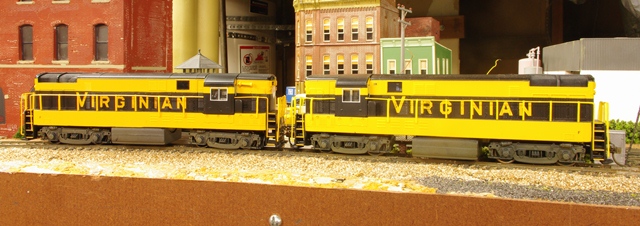
The only place they were numbered was in the end number boards. I need to add numbers and builders plates, underframe bells, MU hoses, and slight weathering. After the N&W merger they got numbers 100 higher and N&W numbers added to the cab sides.
Posts: 1,682
Threads: 101
Joined: Dec 2011
jwb Wrote:The Virginian was one of the first prototype railroads that inspired my interest -- I was maybe 12 years old when it merged into the N&W, and I was just starting to realize there were individual railroads that went to particular places, with individual characters. I've picked up most of the books and videos covering the VGN over the years, and while I like it, I'm realizing it's not the best railroad to model for a number of reasons, the really great MR project layout aside. Nevertheless, it's one of my "minors". I realized earlier this year that Bachmann had come out with new runs of the VGN FM H16-44, with much improved paint from the 1990s version, better wheels, and smoother opertion generally. I got one of the new ones very cheaply off Amazon, plus a new body shell to update a 1990s I already had:[ATTACHMENT NOT FOUND]
This is in the spirit of some of Reinhard's Bachmann discoveries, and these are actually a better deal than the GP50 or 70-ton, since they have flywheels and somewhat better details. I think Bachmann is missing a bet here, actually, since they apparently just have Virginian units in stock, when late FM H16-44s in this style ran on the N&W in both black and blue, the AC&Y, the B&O, the New Haven, the Penn Central, Bosques de Chihuahua, CP, and CN -- and these are good-running, acceptable layout models, in a time when we can probably kiss goodbye to Atlas Classics and Athearn RTR locos of only slightly better quality for less than $150.
The Virginian had 40 FM H16-44s numbered 10-49, in two body styles. The ones in the late style like the Bachmann were (I think) numbered 35-49. Only the end handrails differ on the model. Here's a postcard photo from my collection:[ATTACHMENT NOT FOUND]
The only place they were numbered was in the end number boards. I need to add numbers and builders plates, underframe bells, MU hoses, and slight weathering. After the N&W merger they got numbers 100 higher and N&W numbers added to the cab sides.
You just reminded me I got an old CP Bachmann H16-44. Sweet engine, but would need to be upgraded. These engine carbody design make them look so powerful, ugly, yet lovable... (hum... well, like anything related to trains!). If only Bachmann could get CN green/gold colors, life would be so easier.
Matt
I have a CP unit, too. I think they were only done in the 1990s, and I intend to order a pair of replacement trucks with upgraded wheels from Bachmann. You're right about not being able to get them in good paint schemes -- seems if Bachmann can do the FA-2 and GP9 in CN green, they ought to be able to do this one, too.
Here's another area where I need to do some work. It's one of the older parts of my layout, which I started around 1989 and moved to our current place in 1993. The name of the area is tentatively CP West Zenith:

As you can see, the ballast in the foreground is in bad shape. I did it a long time ago with Woodland Scenics ballast, which is made from ground walnut shells. This area is under a basement pipe that's been a problem, and it's had falling water several times, and I need to redo the ballast with Arizona Rock & Mineral, which is more robust. But while I'm at it, I've decided I'm going to relay the outside track with concrete ties.
Here's a closeup of the control point area.
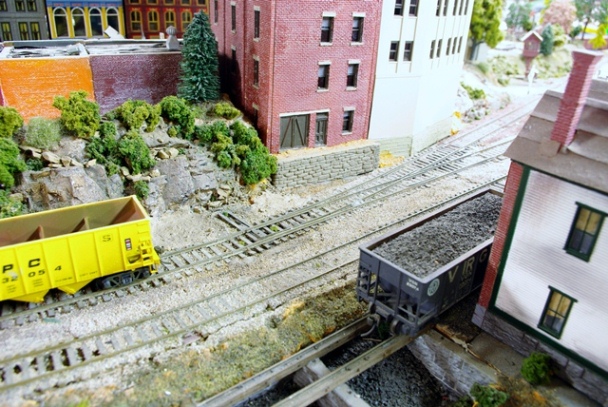
I have a BLMA two-track modern signal bridge, which will go well with the concrete ties on the outside track. I had originally decided this would have a manual switchstand, but I've rethought it, so the switch will need a Details West switch machine and probably a switch heater while I'm at it.
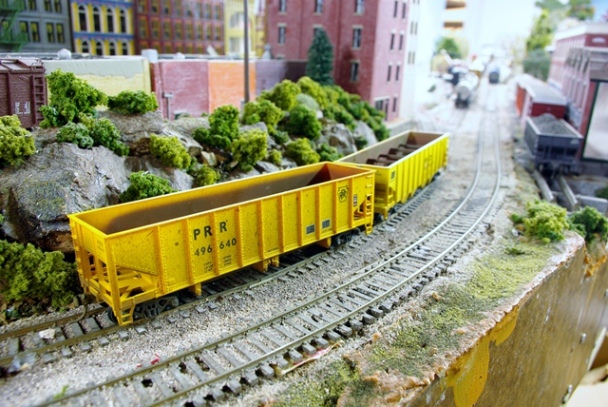
Here's the BLMA signal bungalow that will go at this point once I've cleared out a little scenery and updated the ballast.
More to come on my various projects.
When I post photos, I make progress! Here's another step in the work on this area, some Radio Shack components I've put together to extend the switch machine relay contacts so I can run several signals off them:
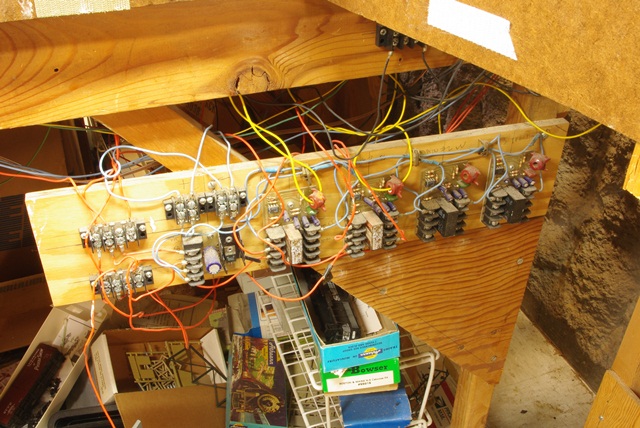
While this will take care of the switch direction at the control point, block occupancy will come from some Dallee Electronics detectors already mounted under the table nearby:
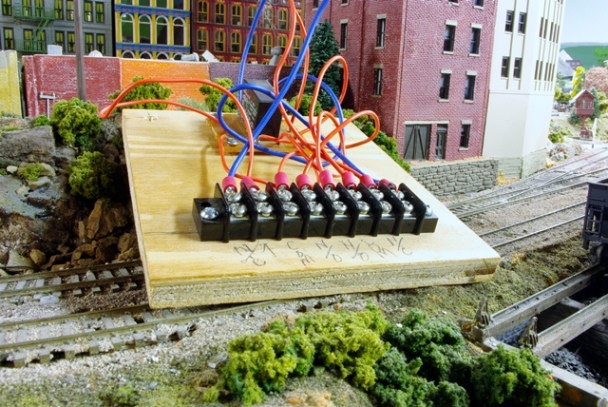
I'm not the neatest at wiring -- for the same reason, I think, that guys have a hard time wrapping gifts -- but it's color coded, and it works (so far).
Another item I found at the swap meet yesterday was a Revell sandhouse. The die work is from the 1950s. A few parts were missing (par for the course at a swap), and the original owner had started to brush-paint some of the detail, which didn't work very well (also par for the course). As soon as I got it home, I started preliminary airbrush work.

This is the view from the front. Not bad detail, sort of George Sellios ten years before his time! When I found it, I sort of knew I had a place for it, but I wasn't sure exactly where. I tested it out in a few places and discovered the best one is where it faces the other direction, but it's about 18 inches from the front of the benchwork here, and it doesn't matter a whole lot. It does fill the space very nicely.
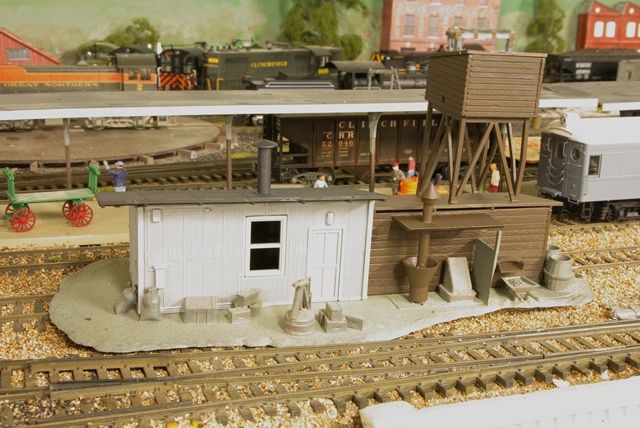
So now I need to add some detail, trim paint, and weathering and blend it into the site.
|
![[Image: gaugetraingifsigUP.gif]](http://i79.photobucket.com/albums/j137/wprm/gaugetraingifsigUP.gif)
![[Image: gaugetraingifsigUP.gif]](http://i79.photobucket.com/albums/j137/wprm/gaugetraingifsigUP.gif)




![[Image: 2003110513255716272.jpg]](http://imagestorage.nerail.org/photos/2003/11/05/2003110513255716272.jpg)
![[Image: logosmall.png]](http://i543.photobucket.com/albums/gg445/CAB_IV/Model%20Trains%202013/logosmall.png)